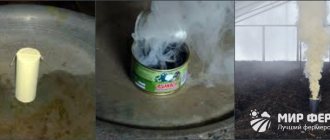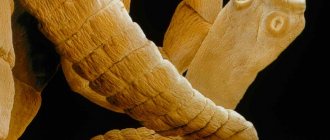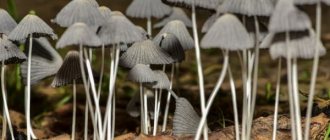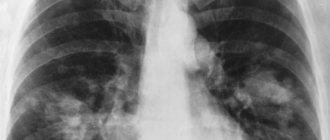Everyone knows firsthand that if you leave food at a warm room temperature for a long time, white mold with a rough surface appears on the food, which gives off an unpleasant odor. This mold is called mucor mushroom. It can be found not only on products, but also on soil and various organic residues.
Mucor refers to fungi that can have a negative effect on the human and animal body and cause diseases. Despite this, it is often used to produce antibiotics, starter cultures and fermented foods. The second name of the microorganism is white mold.
Drawing and structure of a mold fungus
Mushrooms of the genus Mucor can be found in soil, droppings, and on expired food products.
The formation of the fungus occurs in the form of mycelium - white mold, which is visible to the naked eye.
Then the mucor begins to rise upward through hyphae, on which sporangiophores mature. Spherical thickenings form at their ends. Microscopically, in these formations the nuclei are located in large numbers, which leads to compaction of the cytosol (cytoplasm) at the periphery.
The picture shows the schematic structure of the mucor mushroom. A nuclear-free column is formed in the center, and the marginal structures go to form sporulation organs. As the mucor matures, the sporangium ruptures and the spores are released. When mitospores spill out, part of the membranes remains attached to the wall. Such structures are called “collars”.
Mukor mushroom: description, practical application. What is the danger of the mushroom
Mucor is characterized by only multisporous sporangia. When a swelling appears at the top of the sporangiophore - the future sporangium, it is separated from the sporangiophore by a dome-shaped septum, as a result of which the sporangiophore protrudes into the cavity of the sporangium. The part of the sporangiophorus that is inside the sporangium is called the column. The existence of a column is a distinctive feature of asexual sporulation not only of mucor, but also of representatives of its entire family. Mature sporangia are not separated from the sporangiophorus. Genetically homogeneous sporangiospores are released as a result of spreading or destruction of the sporangium membrane. The spores give rise to new mycelia.
The easiest way to grow the Mukor mold is on white bread.
An important feature of eukaryotes is the presence in their cytoplasm of cellular organelles that have their own small genome (a set of genes) and reproduce by division. These are mitochondria, and in higher plants - chloroplasts. They may have originated from cellular symbionts: the former from aerobic bacteria, and the latter from cyanobacteria. All cells with mitochondria use oxygen; only a few eukaryotes have lost the ability to aerobically metabolize.
What mucor looks like under a microscope
Fungi are eukaryotes - organisms whose cells contain a formed nucleus.
The cell contains:
- cell membrane;
- cytoplasm and nucleus that make up the protoplast;
- vacuoles are cellular elements responsible for intracellular digestion.
The cell membrane of mucor contains chitosan. The latter perform a supporting function. Thus, the framework of the mycelium and hyphae is the cell membrane, which can calcify during life. The structure of the fungus contains a plasmalemma that delimits the protoplast. It is necessary to control substances entering the cell. The main energy substance is mitochondria, immersed in the cytoplasm along with other organelles.
Another component of the protoplast is the nucleus. A significant number of nuclei are part of the mycelium - the body of the fungus. The role of roots is performed by hyphae. They can be separated by partitions - septa, which are absent in mucor. Therefore, this representative consists of nonseptate hyphae. In terms of the growth rate of hyphae, mucor fungi are fast-growing.
What is the difference?
The main difference between Yeast and Mucor is that Yeast is a single-celled fungus which is not filamentous whereas Mucor is a filamentous fungus which is a form of mycelium .
Fungi are eukaryotic microorganisms with a thallus-like body structure. Some fungi are unicellular. Yeast is an example of a single-celled fungus. But many fungi are multicellular and have mycelium. One of the unique features of fungi is that they have chitin in their cell walls. In addition, fungi are very good decomposers (these are organisms that process the remains of living things), since they are usually saprophytes. Yeast and Mucor are two different types of fungi that have similarities as well as differences.
Content
- Overview and main differences
- What is Yeast
- What is Mukor
- Similarities between Yeast and Mucor
- What is the difference between Yeast and Mucor
- Conclusion
What is Yeast?
Yeast is a single-celled fungus. They are single-celled eukaryotic organisms belonging to the fungal kingdom. Yeast fungal species belong to a subphylum called "Saccharomycotina" from the phylum "Ascomycota". There are more than 1,500 types of yeast. Budding is the main method of reproduction in yeast. It is an asexual method of reproduction that occurs through asymmetric cytokinesis.
The growth or bud formed from the parent cell grows into a new yeast cell. However, some species of yeast reproduce asexually by fission. In addition to asexual reproduction, yeast can also reproduce sexually using two different types of mating.
Yeast under a microscope
Baker's yeast (Saccharomyces cerevisiae) is a type of yeast that is used industrially. Yeast's ability to ferment sugars is its most important feature. They are used for making bread, alcoholic drinks such as wine, beer, etc. In addition, yeast is used for ethanol production and for bioremediation.
Some types of yeast cause infections in humans. One example is Candida. Candida species cause candidiasis. Histoplasma and Blastomyces are two other yeast species that are responsible for disease in humans. Accordingly, “Histoplasma” causes Histoplasmosis, and “Blastomyces” causes Blastomycosis.
What is Mukor?
Mucor is a zygomycete fungus that belongs to the kingdom Fungi. This is a mold or filamentous fungus. These fungi are usually found in soil, rotten or spoiled plant matter or food, and some in the digestive system. These are fast-growing filamentous mushrooms, usually white to gray in color.
Mukor
Additionally, they are saprotrophic fungi that depend on decaying organic matter in the environment.
Mucor under a microscope
Reproduction in Mukora has distinctive features. They reproduce through sexual and asexual reproduction. Asexual reproduction in Mucor occurs through fragmentation and sporangiophore formation. The Mukora sporangiophore is branched. Upon reaching maturity, the sporangiophore develops into a sporangium and releases asexual spores. These asexual spores develop into a new functional Mukora mycelium.
Sexual reproduction in Mukora occurs through the mating of two types of organisms under harsh, unfavorable conditions. The gametangium is involved in the sexual reproduction of Mucor through conjugation (joining of homologous chromosomes).
What are the similarities between Yeast and Mucor?
- Both Yeast and Mucor are fungi.
- These are heterotrophs belonging to the kingdom of fungi.
- Both have sexual as well as asexual methods of reproduction.
- In addition, they are very good at decomposing organic matter in the soil.
What is the difference between Yeast and Mucor?
Yeast is a unicellular fungus, while Mucor is a multicellular fungus. So, this is the key difference between Yeast and Mucor. In addition, Yeast is not a mold, but Mucor is.
Basic information - Yeast vs Mucor
Yeast is a single-celled fungus. On the other hand, Mucor is a multicellular fungus that is a mold (filamentous fungus). So, this is the key difference between Yeast and Mucor. In addition, yeast reproduces asexually, by budding. Whereas Mukor uses fragmentation and sporangiophore formation as an asexual method of reproduction.
Reproduction of mucor
The life cycle is represented by two phases of development: haploid and diploid. Mucor exists primarily in an asexual stage. Only the zygote has a double set of chromosomes.
White mold is represented by sporangiophores. It is there that the sporangia mature, in which sporangiospores are formed.
The sexual stage is called zygogamy. The mycelia unite to form partitions, which is how the contents are combined. As a result, a zygote is formed. A necessary condition is the contact of mycelium of the opposite sign; only in this case is the fusion of male and female cells possible.
When exposed to favorable conditions, the zygospore germinates. Subsequently, during meiosis, only one nucleus remains in the cell. After this, the cell enters a state of mitosis. According to the method of reproduction in the life cycle, the haploid stage predominates.
Classification
Mucor and penicillium fungi are representatives of the class Zygomycetes. Their mycelium is represented by a noncellular structure without partitions. This is a characteristic feature of lower fungi. Taxonomists distinguish 60 types of mucor. This fungus is also called white mold because its hyphae form a light coating on the substrate.
The mucor mycelium is one large unbranched cell, the cytoplasm of which contains a large number of nuclei. Partitions, or septa, are formed only during the breeding season. This ensures the separation of sporangia, which are the reproductive organs of lower fungi.
Mushroom nutrition
Occurs in an oxygen environment with high humidity. Whole organic matter is an ideal environment for the existence of fungi.
White mold is a saprotroph.
Regarding food products, the following conclusion suggests itself: the higher the carbohydrate content in the environment, the more favorable it will be for the development of moldy mucor. These include:
- potato;
- bread;
- dairy products.
Useful properties and scope
There are about 60 types of mold, which are widely used in various fields of human activity. In the food industry, mucor is used to make famous types of cheeses, such as tofu and tempeh. These cheeses are prepared using a mushroom starter.
In Italy and Spain, which are famous for their abundance of meat products, white mold is used to produce sausages. So, for a month, sausage is stored in a dark, cool room under a layer of mold, after which the products are processed, and after a few months they arrive on store shelves.
The mushroom is often used to produce potato alcohol. This use is based on the activity of fungal enzymes. It is also used in the production of fermented milk products. Mucor is considered a valuable material in medicine, where the antibiotic ramycin is obtained from it.
You may be interested in:
Description and photos of edible mushrooms Mushroom pickers are not born, but become. You can master the complex science of edible and poisonous mushrooms at any age,...Read more...
Due to the wide range of uses of mucor, it is grown in special laboratories. To do this, create a favorable living environment in a separate container, for example, moisten a piece of bread. After which the container is insulated and tightly covered. The container with the substrate is placed in a warm place with a temperature of at least 20 degrees, where after a couple of days colonies of the fungus begin to grow.
Danger of white mold
In relation to human life, mucor is a parasite. It grows in polluted conditions, most often the habitat is expired food products.
Pathogenic pathogens can cause mucormycosis of internal organs. When they settle on food products, they develop mold. Eating contaminated products can lead to dysbiosis, poisoning, and irritable bowel syndrome.
Application
Mold is used in cooking
Today, industry actively uses various representatives of the fungal kingdom to obtain compounds necessary for humans. Much research is devoted to the survival of organisms in space conditions. Culinary organizations are also interested in mold cultivation.
In cooking
The mucor mold is a source of substances in the food industry:
- for the production of fermented food products (soybeans, cereals);
- for producing ethanol from potatoes;
- for making fermented milk (as a starter).
- In cheese making to produce types with noble mold (“blue cheeses”).
- During salami production, it prevents the appearance of dangerous plaque, improves consistency, aroma, and reduces acidity.
- For the synthesis of enzymes.
In medicine
Some types of mucor fungus are suitable for producing antibiotics. Representatives of the genus Penicillium are used to obtain the most famous antibiotic - penicillin, and from other types of mushrooms the substances griseofulvin, mevastine, mycophenolic acid, used as immunosuppressants, are obtained.
Growing methods
The easiest way to grow the Mukor mold is on white bread.
The saprophyte loves carbohydrates, so it willingly settles on flour products, potatoes, and fruits.
To get moldy bread, you need:
- Moisten a piece of bread with water. It is a favorable substrate.
- Place in a plastic bag or cover with a glass jar and place on a saucer.
- Keep it in high humidity conditions at a temperature of 20 to 25℃. Mold forms up to 37℃.
- Over time, a white coating will appear on a piece of bread. If you leave it longer under the same conditions, it will darken due to ripening spores.
We grow mucor (mold).
What Happens If You Eat Blue Bread
Growing mold at home (for school)











